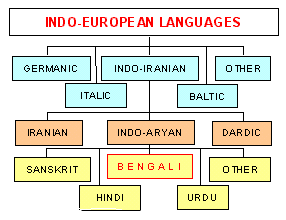 Linguists claim that all languages are cognate and have common origins. To trace the origins of the Bengali language let’s begin at the beginning. Bengali belongs to the easternmost branch of the Indo-European family of languages (spoken by about half the world’s population), called the Indo-Iranian branch (See Figure). Bengali descended from the Indo-Aryan branch of the Indo-Iranian family, which includes old and obsolete languages like Sanskrit, Pali, Prakrit and modern languages like Hindi, Urdu, Gujarati and Sinhalese.
Linguists claim that all languages are cognate and have common origins. To trace the origins of the Bengali language let’s begin at the beginning. Bengali belongs to the easternmost branch of the Indo-European family of languages (spoken by about half the world’s population), called the Indo-Iranian branch (See Figure). Bengali descended from the Indo-Aryan branch of the Indo-Iranian family, which includes old and obsolete languages like Sanskrit, Pali, Prakrit and modern languages like Hindi, Urdu, Gujarati and Sinhalese.Going deeper, we find that the direct ancestor of Bengali was a form of Prakrit, a Middle Indo-Aryan language, which descended from Sanskrit or Old Indo-Aryan. Sanskrit was the spoken and the literary language of Aryans until circa 500 BC, after which it remained for nearly 2000 years the dominant literary language as well as the lingua franca among the cultured and the erudite throughout the Indian subcontinent. But, soon the spoken language, conditioned by the regional linguistic and ethnic environments took up the different regional new Indo-Aryan languages.
The emergence of these new Indo-Aryan languages and dialects was not all synchronized. But some of them, including Bengali, certainly originated by the middle of the 10th century AD. For old Bengali the only records are mystical songs discovered in a manuscript from Nepal by historian and author Haraprasad Shastri. The language of the these songs is basically vernacular, but at the same time it is also something of a literary language.
Current Bengali language has two distinct styles and dialects: ‘Sadhubhasha’ or elegant language and ‘Chaltibhasha’ or current language. The former, which is less intelligible to the uneducated, is the traditional literary style based on the Bengali language of the 16th century, and has a vocabulary consisting of many Sanskrit words The latter is mostly a creation of the 20th century, and is based on the cultivated form of the dialect spoken in Calcutta by the educated Bengalis as well as by the common people coming from districts surrounding the Hoogly river.
Like all Indian scripts, the Bengali script, originated from the Brahmi alphabet of the period of Emperor Ashoka. The Bengali alphabet in its present printed form took shape in 1778 when printing types were first cast by Charles Wilkins. There still remained a few archaic forms that were finally replaced in the middle of the 19th century by a well-defined alphabet.
Today Bengali is among the major modern languages of the world. It is the first of the Indian languages to develop Western secular literary styles, such as fiction, drama and odes. It is also the only South Asian language to have a Nobel laureate in literature - Rabindranath Tagore (1861-1941) - the chief monument of Bengali literature.
© 2010 Subhamoy Das. All rights reserved.

No comments:
Post a Comment